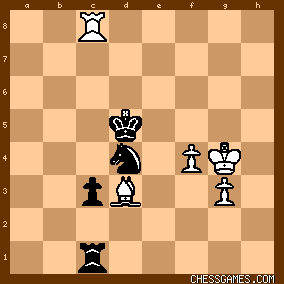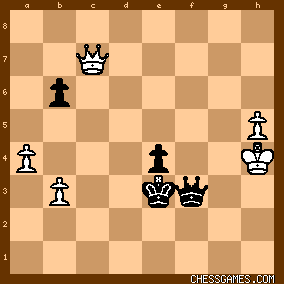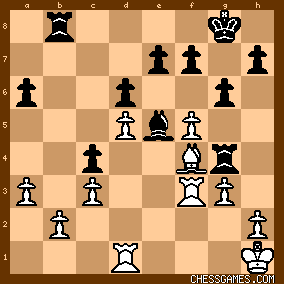|
This match played in Reykjavik from 6 March to 2 April 1957 was proposed by Herman Pilnik (1) during a visit to Iceland for the Reykjavik tournament in July. It was his opportunity to revenge his comprehensive 5 to 1 loss in Pilnik - Olafsson (1955). Once again, the two played sharply in a ferocious match, with only one drawn game, but this time the result was much closer. Fridrik Ólafsson had been in good recent form at the Moscow Olympiad and at Hastings (1956/57). Pilnik had finished last in the extremely strong Amsterdam Candidates (1956) (+1 -9 =8) but had rebounded and come second at Hoogovens (1956). Progress of the match The match was of six games, and if it was tied at that stage two more games would be played. (1) 1 2 3 4 5 6 7 8
Ólafsson 0 1 0 1 0 1 1 ½ 4½
Pilnik 1 0 1 0 1 0 0 ½ 3½
Pilnik had white in the odd-numbered games. Progressive scores: 1 2 3 4 5 6 7 8
Ólafsson 0 1 1 2 2 3 4 4½
Pilnik 1 1 2 2 3 3 3 3½
Game 1. In a Ruy Lopez, Ólafsson was outplayed from an equal position. He shed a pawn and then a second for no compensation as Pilnik pressed on with his attack. Game 2. This was the longest game of the match, a marathon of 105 moves. This time it was Pilnik who was outplayed, but deep into the ending. 
click for larger viewPilnik lost his passed pawn and then sacrificed his knight for a R v R+B ending. He held on for a long time but finally made a fatal move with 
click for larger view98...Rh4 which allowed Ólafsson to weave a mating net. Game 3. This is probably the best-known game of the match as Ólafsson's blunder lost him a drawn game. By exchanging Queens, he was unable to deal with White's passed pawns on either wing and was a tempo short to queen his own passed <e> pawn successfully. 
click for larger viewThe score was now 2-1 in favour of Pilnik.
Game 4. After the longest game of the match came the shortest. Pilnik suddenly lost the thread, and Ólafsson smashed through to his king with a queen sacrifice after only 24 moves: 
click for larger viewGame 5. Ólafsson as Black equalized, using the Dragon variation of the Sicilian Defence, but once again a mistaken exchange of Queens led to problems. In this case, his Rook was trapped on the king-side. 
click for larger viewDespite losing the exchange, Ólafsson fought on. But when Pilnik returned the exchange for two powerful connected pawns on the king-side, the result was never in doubt. Pilnik now led 3-2 and would win the match if he could win the next game as Black. Game 6. This game resembled Game 4. Having lost the preceding game, Ólafsson sprang back with a quick win against the Sicilian Defence. Once again Pilnik was overrun on the kingside, and seemed to have problems defending positions where his king was vulnerable. 
click for larger viewAfter 20...g6?, Ólafsson broke through in short order. It seems surprising that Pilnik suffered such defeats in both games 4 and 6 as the Sicilian was his primary defence. The score was now equal and the match went into overtime. Game 7. Ólafsson surprisingly used the Alekhine Defence. He had introduced a novelty in the 1955 match by deploying a Petrov and now he repeated his psychological ploy. Both players followed what is still mainline theory and the position was dynamically equal when Pilnik blundered away a pawn. He had to defend a Rook and pawn ending a pawn down, but despite both players queening pawns, his King was driven towards a mating net. Game 8. In the final game, Pilnik with Black again chose the Sicilian Defence despite his lack of success with it so far in the match. He used the Richter-Rauzer variation and secured equality. He could not achieve any more and as material was exchanged his chances of tying the match slowly faded away. The game was drawn after 71 moves, giving Ólafsson the match. Note
(1) Skáksögufélagid webpage, http://skaksogufelagid.is/1957-einv.... The date of the last game is from Tíminn, 3 April 1957, p. 12. User: Chessical - original text and compilation.
| 



![]()
